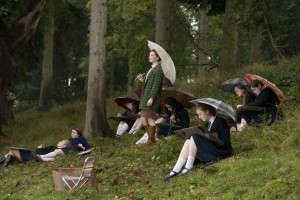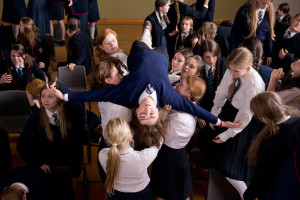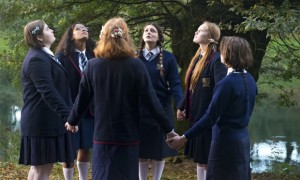By Paul Risker.
Worlds continue to merge as Carol Morley instigates an ongoing collision between narrative fiction and documentary within her young oeuvre. But with her most recent narrative fiction film The Falling (2015), this collision extends to the very fabric of the film itself. Beneath the surface of its hysterical waters there lies deeper conflicts that cast the film with a troubling identity. One of these conflicts stems from art’s dependency upon the individual, and therein the human frailties that can inflict upon it scars of imperfection. Of course, within a creative realm which can categorically define neither perfection nor imperfection, this is in and of itself an uncertain discourse. If, however, these human flaws are present in Morley’s The Falling, then by a logical progression of thought her tale of mass psychogenic illness and mass hysteria in an all-girls school is one that is infused with an imperfect, human like identity.
 The frustrating experience that The Falling reveals itself to be is imbued with a sense of the imperfect everyday narrative. Typically the pockets of anecdotes taken by narrative fiction, which are then threaded together to create a more convenient and ideal story that is told succinctly, see disused narrative threads of life removed. But here one suspects Morley’s intention, whether conscious or not, was to salvage this imperfect everyday feel. However, by stepping into the realm of film the rules of the game are wholly different to that of narrative reality.
The frustrating experience that The Falling reveals itself to be is imbued with a sense of the imperfect everyday narrative. Typically the pockets of anecdotes taken by narrative fiction, which are then threaded together to create a more convenient and ideal story that is told succinctly, see disused narrative threads of life removed. But here one suspects Morley’s intention, whether conscious or not, was to salvage this imperfect everyday feel. However, by stepping into the realm of film the rules of the game are wholly different to that of narrative reality.
The stage for her tale offers a terrain rich with adolescent angst and high emotion. Outside of the collision between narrative fiction and documentary, Morley crafts a tale in which the personal and communal harmonically collide. It is a collision that define the film as a personal drama in the shell of a communal drama. However, the collisions within the fabric of the film refuse to cease fire, as the everyday brimming with the high emotions of adolescence are offset by a haunting sense of feeling, as if the veil between reality and the supernatural; the conscious and the unconscious worlds were wearing thin. And entering this playground of adolescent angst like a puppeteer, Morley sets about toying with the multiple threads that lace her drama: sexuality, acceptance, and the quest for the truth in the face of ignorance, which invariably creates ever unsettling ripples in the already dramatic waters.
 But in speaking of the film possessing a human like identity, the inference of a supernatural quality radiates outward from the haunting sense of feeling that can be attributed to the visual and audio aesthetic. Meanwhile, the mention of lay lines and the presence of Jungian psychology serves to bring the film into the gravitational pull of the unconscious and collective unconscious. What Morley seemingly creates here is a humanist identity through the creation of two levels that inevitably collide: consciousness and unconscious. The Falling therein has the feel of a complex human mind, personality and texture, and this swirling chaos of collisions aptly captures the ontology of the human experience.
But in speaking of the film possessing a human like identity, the inference of a supernatural quality radiates outward from the haunting sense of feeling that can be attributed to the visual and audio aesthetic. Meanwhile, the mention of lay lines and the presence of Jungian psychology serves to bring the film into the gravitational pull of the unconscious and collective unconscious. What Morley seemingly creates here is a humanist identity through the creation of two levels that inevitably collide: consciousness and unconscious. The Falling therein has the feel of a complex human mind, personality and texture, and this swirling chaos of collisions aptly captures the ontology of the human experience.
Just as life is a conflict between the introverted and extroverted sides of our personalities, which offsets the preservation of our individual identity with the desire to communally belong, so film functions in much the same way. In a conversation with Morley, she explained: “You take it 90% of the way, and it is the audience that finishes it. So the audience by bringing themselves, their experiences, opinions and everything else to a film, is what completes it.” This perspective is one that illuminates the discussion of the collaboration between the filmmaker and the audience, specifically those moments in which the filmmaker is required to show their hand to the audience in contrast to those moments in which they can trust the audience to put the rest of the pieces into place for themselves. But invariably film is structured around spectatorial expectations, and the tendency of film literate audiences to determine in their own minds the preferred narrative avenues from which pleasure or displeasure derives.
 If there is an abiding weakness with The Falling, it is that it could be accused of lacking a clarity of voice. This leads one to question whether it knows exactly what it wants to say. But more specifically it asks whether it knows which story avenues to seal off as a sacrifice for other narrative strands to remain open, which can then be fully utilised and realised in a satisfactory way. The appealing conscious and unconscious aesthetic is offset by what will for some be the unappealing flirtations or teasing demeanour of the film in which Morley keeps one foot in the everyday and the other in the supernatural. One impression that will form is that she teases us with undercurrents and leaves us to feel as though we are children dancing around the tree that we are never allowed to climb. It leaves us feeling as though we are being denied a pleasure in the experience, and the film never feels as if it reaches a full maturation but rather is held back.
If there is an abiding weakness with The Falling, it is that it could be accused of lacking a clarity of voice. This leads one to question whether it knows exactly what it wants to say. But more specifically it asks whether it knows which story avenues to seal off as a sacrifice for other narrative strands to remain open, which can then be fully utilised and realised in a satisfactory way. The appealing conscious and unconscious aesthetic is offset by what will for some be the unappealing flirtations or teasing demeanour of the film in which Morley keeps one foot in the everyday and the other in the supernatural. One impression that will form is that she teases us with undercurrents and leaves us to feel as though we are children dancing around the tree that we are never allowed to climb. It leaves us feeling as though we are being denied a pleasure in the experience, and the film never feels as if it reaches a full maturation but rather is held back.
If The Falling is aptly described as a personal drama in the shell of a communal drama, then from speaking with Morley perhaps a further conflict is at work. This conflict is one that derives from the research of mass psychogenic illness and mass hysteria, and the pursuit to create authenticity that invariably clashes with the ontology of narrative fiction. While narrative fiction derives from reality and the everyday, they are two separate entities that are based on different ontological rules. Reality within narrative fiction invariably requires the careful and delicate balance of reflecting reality without compromising the integrity of the narrative fiction. The latter of these is a representation or little white lie with a licence to imagine in the hands of the storyteller, and it is from here that the preservation of the everyday narrative perhaps conflicts with a film that one feels wants to be a little less mysterious and ambiguous; even teasing.
 Despite the communal setting of the school where adolescent angst meets mature frustration, Morley’s focus is on retaining an intimacy to the drama. But there is the inescapable impression that while the haunting presence will intrigue some, Morley is less intrigued with this side of the narrative. Consequently, if she teases us with the prospect of a haunting subtext, then its lack of maturation resembles those childish ghost stories or supernatural tales that adolescents share, their fertile imaginations looking to the world beyond their own which is already vast and marginally explored by their adolescent selves. From this perspective, The Falling is an intriguing film that at its heart captures the collision between intimate and communal drama, wherein Morley connects her filmic world to the mysterious and ambiguous realm of the supernatural that religion has exploited and rooted itself in. So often in life, faith and the supernatural remain shrouded in shadow as we progress with our everyday life. Explanations for these subjects remain unclear, and in The Falling Morley mirrors the quandary and ambiguity of the everyday.
Despite the communal setting of the school where adolescent angst meets mature frustration, Morley’s focus is on retaining an intimacy to the drama. But there is the inescapable impression that while the haunting presence will intrigue some, Morley is less intrigued with this side of the narrative. Consequently, if she teases us with the prospect of a haunting subtext, then its lack of maturation resembles those childish ghost stories or supernatural tales that adolescents share, their fertile imaginations looking to the world beyond their own which is already vast and marginally explored by their adolescent selves. From this perspective, The Falling is an intriguing film that at its heart captures the collision between intimate and communal drama, wherein Morley connects her filmic world to the mysterious and ambiguous realm of the supernatural that religion has exploited and rooted itself in. So often in life, faith and the supernatural remain shrouded in shadow as we progress with our everyday life. Explanations for these subjects remain unclear, and in The Falling Morley mirrors the quandary and ambiguity of the everyday.
In this single tale burgeoning sexuality of adolescence and the moral quandary as to whether it is right or wrong to be explored or even experienced crosses paths with the supernatural. Meanwhile the psychological and the mystical; the conscious and the unconscious collide with an aesthetic explosion. As the credits roll one is left with the lingering impression of having experienced a film which on some level resembles a swirling and heady chaos with a humanist identity. If dreaming is a vital and inherent part of the human experience, then The Falling could almost be perceived as existing on a dream logic in which anything and everything can collide with aesthetic and narrative abandon. But are we biased and rather than looking at the film as more of an interaction that needs not enthrall from start to finish or be a tidy and satisfying narrative construction, can intellectual reasoning and reflection not raise a film above narrative and technical aesthetic pleasure and satisfaction? Perhaps within the realm of narrative fiction, Morley herself collides with a world whose rules she fights with to cast film as a humanist entity. It’s a frustrating experience, as we never get to climb the tree, but The Falling is a film that provokes contemplation and this in and of itself is reason enough for it to exist.
Paul Risker is a critic and writer for a number of on-line and print publications, including Little White Lies, Flickering Myth, Starburst Magazine, and VideoScope. He is currently based in the United Kingdom.

